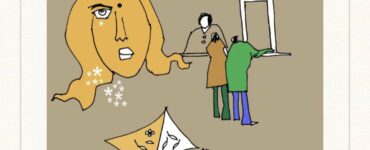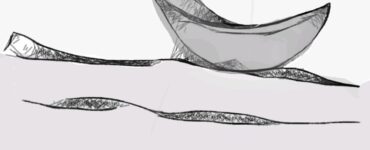The Wreck-9(V.19-25)
Sister, a sister calling
A master, her master and mine!—
And the inboard seas run swirling and hawling;
The rash smart sloggering brine
Blinds her; but she that weather sees one thing, one;
Has one fetch in her: she rears herself to divine
Ears, and the call of the tall nun
To the men in the tops and the tackle rode over the storm’s brawling. 19
As the ship was taking on water,the captain ordered all the passengers on deck. Some men were clinging to the rigging. The women could not climb the ropes and hold the rigging. They were helplessly watching the water pouring in. At that moment of surging death, one of the five Fransiscan nuns,the six plus footer, called out to Christ, her master. At this point of the narrative, the poet identifies himself with the tall nurse. For, the storm the tall nurse was in was not different from the storm in him , of which he spoke in the first part of the poem. The external storm is a symbol of the internal storm of the poet described earlier . The sea is no longer out, it is very much in , (“the inboard seas”). So, the tall nun and the poet are now on the same deck, or more literally, sailing in the same ship, but not in sinking spirits . This camaraderie in calamity is expressed in the words, “her master and mine!” The two have the same master. The ship has passed out of shipmaster’s hands, and is now in the command of another master,your master,my master, and master of all. ( “Was calling ‘O Christ, Christ, come quickly’:The cross to her she calls Christ to her“ v.24; Thou mastering me”. V.. Actually, the ship’s captain never appears in the poem.)The tall nun was calling Christ, and the cross! The sea does not creep in quietly,but it runs, (“run swirling and hawling”.) “Run”, the sea is running in, and time is running out. The sea water blinded the nun (“The rash smart sloggering brine /Blinds her”). And, that is the moment she “sees”, and sees “ one thing” , ( “she that weather sees one thing”). Visual infirmity bestows spiritual vision,and the spiritual vision shuts out the many and reveals the “one”. She called, and the call was so emphatic that it drowned the “swirling and hawling” of the sea, and the howling of the men and women in panic,(“rode over the storm’s brawling”).
The tall nun called when she realized that for the ship, and for her, there is but a short distance to travel , (‘ Has one fetch in her ‘).And her call was to the “divine Ears”. The tall nun is invoking the Christ, who commanded sea to peace,( ‘Peace, be still’: Mark 4:36-41.) But she called Christ not to calm the sea outside, but the sea within.She called the Christ in. It would be her conception of the Christ. It is her invocation to the cross.
She was first of a five and came
Of a coifèd sisterhood.
(O Deutschland, double a desperate name!
O world wide of its good!
But Gertrude, lily, and Luther, are two of a town,
Christ’s lily and beast of the waste wood:
From life’s dawn it is drawn down,
Abel is Cain’s brother and breasts they have sucked the same.20
The five Franciscan nuns were “coifèd”, wearing the headdress of their order. “The tallest of the five sisters was tall not merely physically.”She was first of a five”. Hopkins, a convert to the catholic faith, is undeserved in his reproach of the Protestant the other sect of the faith. He does not hide his disapproval of the protestant faith,and its founder, Luther .The Deutschland is not only the name of the ship ,but as well of the land of Luther, where the anti-Catholic‘Falck Laws’,under Bismarck , drove the nuns into exile.Deutschland is the German word for Germany. And Hopkins is suggesting that Germany with its religious intolerance is also a spiritually sinking ship. But the land cannot be faulted. For the same motherland can produce a Luther and a lily, Gertrude, (the Catholic saint Gertrude: c.1256-c.1302). Luther and Gertrude inhabited the same town, Eisleben.) To Hopkins, the Deutschland is the beast “waste wood”). Hopkins compares this congenital contrast of Luther and St. Gertrude with Abel and Cain,( Genesis 4:1-16) who sucked the same breasts. We may also think of Edmund and Edgar of “King Lear”.
Hopkins’s tone in his condemnation of Protestant intolerance in this verse seems a little uncharacteristic of him. However it has to be understood as the depth of his pain at the tragedy.
Loathed for a love men knew in them,
Banned by the land of their birth,
Rhine refused them, Thames would ruin them;
Surf, snow, river and earth
Gnashed: but thou art above, thou Orion of light;
Thy unchancelling poising palms were weighing the worth,
Thou martyr-master: in thy sight
Storm flakes were scroll-leaved flowers, lily showers—sweet heaven was astrew in them. 21
These five nuns, among thousands others,had to flee the motherland for no wrong but their love of men. But God does what man thinks he has undone.“Unchacelling” has a hidden irony it. It refers to the convent chapel, and Chancellor Bismarck. Bismarck was “unchacelled” by God who salvaged the sisters in his own way.
“Rhine refused them, Thames would ruin them”. The apparently unbecoming tone of religious intolerance in the previous verse has been balanced in this. If German river refused, the English Thames did no better. In verse 35, the poet refers to this misfortune more literally. The blame could be laid ‘at our door’ too .
Not “land” alone, but “Surf, snow, river and earth” , the elements united, the whole nature turned against, the unfortunate passengers, and in particular, the five sisters who dedicated their lives in God’s service.
God was balancing in his palms whether to allow these sisters to perish as mere mortals or as martyrs. Were they hunted by the devil of religious bigotry? No, by Orion, the hunter god,(“thou art above, thou Orion of light.”, god associated with storms and martyrdom (“Thou martyr-master: in thy sight”.) “Storm flakes were scroll-leaved flowers, lily showers—sweet heaven was astrew in them.”“Sweet heaven”. was showering flowers in the form of storm flakes. And it is only, in the world’s eyes they were storm flakes, but flowers in God’s vision,
Five! the finding and sake
And cipher of suffering Christ.
Mark, the mark is of man’s make
And the word of it Sacrificed.
But he scores it in scarlet himself on his own bespoken,
Before-time-taken, dearest prizèd and priced—
Stigma, signal, cinquefoil token
For lettering of the lamb’s fleece, ruddying of the rose-flake. 22
Here is some religious numerology, multiple significance of the number ‘five’. The nuns are five. Christ’s wounds are five . The five leaves (‘cinquefoil ) of the rose representing the wounds ,”ruddying of the rose-flake.” The red rose is the traditional symbol of martyrdom. Hopkins asks us to “Mark, the mark is of man’s make”. It is man who unendingly crucifies the Jesus in him. But the martyr who sacrifices himself carries the marks of martyrdom on him, (“scores it in scarlet himself on his own bespoken, /Before-time-taken, dearest prizèd and priced— /Stigma”)
.St Francis, founder of the Franciscan order, is said to have carried the marks on his body, (“ signal, cinquefoil token /For lettering of the lamb’s fleece.), the marks of the sacrificial lamb, symbol of Christ, the lamb of God. ‘After this I beheld, and lo, a great multitude….stood before the throne and before the Lamb’. (Revelation 7:9)
Joy fall to thee, father Francis,
Drawn to the Life that died;
With the gnarls of the nails in thee, niche of the lance, his
Lovescape crucified
And seal of his seraph-arrival! and these thy daughters
And five-livèd and leavèd favour and pride,
Are sisterly sealed in wild waters,
To bathe in his fall-gold mercies, to breathe in his all-fire glances. 23
This verse is about “the Life that died”,a second birth,(dwijanma), regeneration,die to this life and be reborn into the divine,as seraph 8n heaven. Death is before the eyes,as is now in the poem. Death is a fact of life. The question is how to die, to transform the earthly life into the heavenly . The storm (“wild waters”) is a kind of baptism. “Truly, truly, I say to you, unless one is born of water and the Spirit he cannot enter into the kingdom of God. That which is born of the flesh is flesh, and that which is born of the Spirit is spirit. Do not be amazed that I said to you, ‘You must be born again.”(John 3:5-8)
The storm is thus a manifestation of God’s inscrutable power,terrible and yet ‘fall-gold mercies’. The wild waters ate liquid fire. The sisters are “sealed to Christ” in this baptismal storm.”Fall-gold”,once again, Hopkins once again (as in his poem “Spring.and Fall”)
uses the American Fall. If fall comes can spring be far behind ! The nun’s last breath is a new breathing (“breathe in his all-fire glances”.)(‘He breathed on them and said, ‘Receive the Holy Spirit” :John 20:22)
Away in the loveable west,
On a pastoral forehead of Wales,
I was under a roof here, I was at rest,
And they the prey of the gales;
She to the black-about air, to the breaker, the thickly
Falling flakes, to the throng that catches and quails
Was calling “O Christ, Christ, come quickly”:
The cross to her she calls Christ to her, christens her wildworst Best. 24
Hopkins in this verse contrasts the terrible situation on the doomed deck with his own “loveable west, /On a pastoral forehead of Wales’, (St Bueno’s College in North Wales). He had a roof on his head (“under a roof ”) in contrast to “the black-about air, to the breaker, the thickly /Falling flakes, to the throng that catches and quails” . He was “at rest”. The nuns were “ the prey of the gales”. “ She” (“She to the black-about air, to the breaker, the thickly /Falling flakes, to the throng that catches and quails) could refer to both the ship and the heroine of the poem, the tall nun. But what the poet is particularly thinking of is the sister’s cry of “O Christ, Christ, come quickly”. This was actually what was reported in the newspapers about the nun in her last moments of life. In this worst moment of her life (“her wildworst ”) her best hope is Christ, and he is asking him to come quickly. “Make haste to come to me quickly.”St. Paul.
The majesty! what did she mean?
Breathe, arch and original Breath.
Is it love in her of the being as her lover had been?
Breathe, body of lovely Death.
They were else-minded then, altogether, the men
Woke thee with a we are perishing in the weather of Gennesareth.
Or ís it that she cried for the crown then,
The keener to come at the comfort for feeling the combating keen? 25
Hopkins is pondering on the meaning of the tall nun’s call,”what did she mean?” But before that, “The majesty!” Hers was not a pitiful cry. It was a cry of confidence.
“Breathe, arch and original Breath” Hopkins is obviously referring to God’s breath that breathed all scriptures, and indeed all creation. ” Over its waters stirred the breath of God’ ( Genesis.1:2) The “original” or primal breath referred to here is called Prana in the Vedanta. ( Swami Vivekananda’ “Rajayoga” has a whole chapter on it. The Bible is of course full of references to this eesvarasya nissvasitam.
As the nun is running out of breath, she is crying for God’s breath, a new breath and a new life ( “the breath of the Almighty gives me life. New Living…”(Job.33:4)
“Breathe, body of lovely Death” is the Christ’s body, the original breath that breathes in and breathes out life. The sister is calling Christ not to save this life, but to give her a new life; to breathe out her life only to breathe her in. Here Hopkins is also referring to another story in the Bible, in which Christ was sleeping in a ship,and when it was caught in a storm, his on the deck woke him up in panic to save them.
But the nun, in contrast, did not call him to save her life,but “for the crown” of thorns, the crown of the “master-martyr”( v.21).‘…ye shall have tribulation ten days: be thou faithful unto death and I will give thee a crown of life’ (Revelation 2:10) (Gennesareth is another name of the Sea of Galilee.)
Titbit:
“The letter-writer on principle does not make his letter only an answer; it is a work embodying perhaps answers to questions put by his correspondent but that is not its main motive. Therefore it is as a rule not well to write with a received letter fresh on you. I suppose the right way is to let it sink into you, and reply after a day or two.” (Letter to Baillie)









Add comment